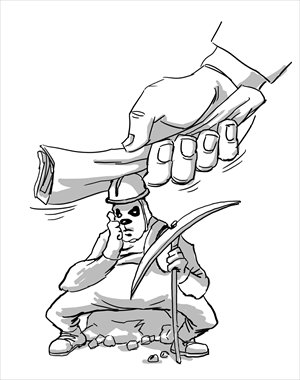China unfairly targeted over Laos railway

I read the New York Times, not just because I live in one of its five boroughs and pay the city tax, but also because I was told that it represents the finest in journalism. That's why I was astounded by the article "Laos Could Bear Cost of Chinese Railroad" recently published in this newspaper.
The story begins by introducing a Chinese hotel owner in Oudomxay Province in Laos, who expects his rooms to be filled by legions of Chinese railroad workers from a nearby construction site, and together with a photo of a Chinese-owned supermarket complex, implies that the Chinese are taking away all the economic benefits of the project.
From there, the authors go on to cite critics who see the financing deal by a Chinese creditor as harsh on the Laos side, and portray the construction as environmentally disastrous. The rest of the article tries to show that the Laos government acts like Beijing's vassal.
I was appalled by the sloppiness of the piece. Starting with the title, I find this story to be loaded with inaccuracies and speculations. The quotes from interviewees are overwhelmingly one-sided, if not biased, and the text employs sensationalism rather than facts and reasoning. In a word, the report appears premeditated to convey the US view.
Calling the railroad "Chinese" is either intentionally misleading or outright ignorant. I believe that the word is certainly not used to describe ownership, otherwise the Laotians wouldn't be happy about US journalists handing over their most expensive infrastructure to a northern neighbor.
Although the project is financed by the Export-Import Bank of China (Eximbank), and a large portion of construction will be carried out by Chinese workers, dubbing it "Chinese" is strange and unprecedented.
The Panama Canal was not named after Citi even though Citibank provided the credit, nor did the first transcontinental railroad take on the word "Chinese" to commemorate the thousands of laborers shipped over from China and died building it.
The story quotes "an assessment of the rail project" by an unnamed "consultant for the United Nations Development Program" that criticizes the "onerous" loan terms by China's Eximbank that would jeopardize Laos' macroeconomic stability, and the construction work that might turn its countryside into "a waste dump."
Such worries, which are not uncommon among US observers, are unwarranted.
The loan is collateralized with underground mineral reserves. In the highly unlikely event of the project's total failure, the loan can be repaid through extraction over the years, and the cash repayment will be minimal.
As for the environmental concerns, construction work is likely to raise dust and produce waste. However, dust settles overnight, and I seriously doubt that a thin rail link in Laos can turn every place along the way into a waste dump, otherwise, with nearly 100,000 kilometers of railroad, China would have long since become a wasteland.
The authors assert that China has no intention of sharing the benefits from the railroad, but spare few words to buttress their point with relevant economic facts and reasoning.
Remember, the train route winds through Laotian territory. Its government pays for the work, owns the system, and is naturally entitled to the revenues it will generate. I don't see how China can run its trains on Laotian tracks and shamelessly pay nothing.
The writers avoid the discussion of Laos' right to charge for use. Instead, they compare projected cost with Laos' GDP in an attempt to convince readers that the country is mortgaging its future and will be submerged in debt. This argument cannot withstand close scrutiny either.
To look at the issue from another perspective, Laos had an estimated GDP of $17.4 billion in 2011 at purchasing power parity (PPP), as opposed to the artificially depressed $8.2 billion quoted by the New York Times article, at the official exchange rate.
The Laotian government takes in about 20 percent of GDP, or $3.48 billion at PPP, as tax. It makes perfect sense for a landlocked country to make a strategically important and productive railway investment that secures access to trading partners and lubricates the movement of essential productive factors.
In fact, most economists would predict that the commissioning of the railway will enable the export of perishable agriculture products, reduce transportation costs, help local farmers and merchants fetch better prices through international trade, facilitate domestic migration of labor, boost processing trade, and so on.
I was amazed to come across this unfit-to-print story on the homepage of the New York Times. Apparently, the principles of balance and fairness claimed by the New York Times don't apply to reporting on China's foreign presence and its rising influence on the global stage, especially when the US government eyes a bigger role through pivoting to Asia.
The author is a Chinese expat based in New York. opinion@globaltimes.com.cn